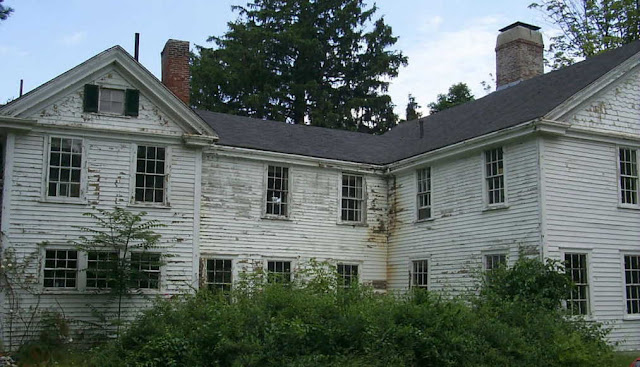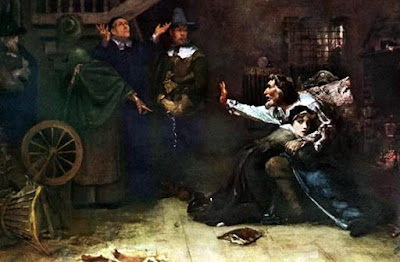"In 1670, [Joanna Blessing Towne], who was by then a defenseless widow, was suddenly accused of witchcraft, although she was never tried for the crime..." (1)
*****
Statue in Salem, Massachusetts of The Towne Sisters
(from Google Images)
Sarah Towne (1639-1703), daughter of Joanna Blessing and William Towne, married Edmund Bridges in 1659 when she was 19. I like to think that they had a nice marriage--they had nine children and all was well until Edmund died in 1682, when Sarah was 42.
The next year, Sarah married my 9th great grandfather, Peter Clayes (or Clay, or Cloyes). (2) They also had a pleasant life, I'm sure. They had three more children, even though Sarah was well into her 40s!
However, in the crazed year of 1692 when Sarah was 53, she was accused of witchcraft and imprisoned. She was not executed--she was either released or escaped from jail. Peter, Sarah, and some members of their immediate and extended families and others who had been persecuted in Salem "moved west" to Framingham, where some of my modern-day relatives live (although the modern relatives are from my father's side of the family).
Peter and Sarah changed their last name from Cloyes (or Cloys) to Clayes in Framingham. There are five houses built by the Salem refugees still standing in Framingham today. (3)
 |
| Peter and Sarah Clayes house, Framingham, Massachusetts (6) Efforts by the Sarah Clayes Museum Project are now underway to save the house.(7, 8) |
Sarah's two sisters were also accused: Mary Towne Easty (or Estey), and Rebecca Towne Nurse (or Nourse). Unlike Sarah, they were executed. Their stories are harrowing, but so well documented that I am going to leave it to others to tell the details. I hope that you will take the time to read about them, if only to honor their innocence.
Mary Easty; The Witch's Daughter (1)
The Trial of Rebecca Nurse (4)
(5)
*****
Sources and Notes
1. History of Massachusetts Blog: Mary Easty, the Witch's Daughter. http://historyofmassachusetts.org/mary-easty-salem/
2. Peter Clayes (1640 - 1708) is my 9th great-grandfather (or my great great great great great great great great great grandfather).
I am descended from Peter Clayes and his first wife, Hannah Littlefield (who died in 1680) through their daughter Sarah Clayes Cunnabell.
Peter's 2nd wife, Sarah Towne Clayes (the one accused of witchcraft), is related to me through marriage but not related by blood. (Don't worry if you're not following--I can only make these statements with the aid of a computer, family tree software, lots of scratch paper, and a genealogical dictionary).
This is how I am related to Grandpa Peter:
Sarah Clayes (1666 - 1700)
daughter of Peter Clayes
Samuel Cunnabell (1689 - 1746)
son of Sarah Clayes
Preserved (Persund) Cunnabell (1727 - 1793)
son of Samuel Cunnabell
Esther "Hester" Campbell (1751 - 1819)
daughter of Preserved (Persund) Cunnabell
Edward Campbell (1795 - 1851)
son of Esther "Hester" Campbell
Tamberlane Campbell (1813 - 1892)
son of Edward Campbell
Elizabeth Campbell (1837 - )
daughter of Tamberlane Campbell
William Giberson (1856 - )
son of Elizabeth Campbell
Edith Rae Giberson (1880 - 1946)
daughter of William Giberson
Elva Myrtle Crabtree (1914 - 1998)
daughter of Edith Rae Giberson
Clair Marie Harris
I am the daughter of Elva Myrtle Crabtree
3. Framingham Biographies: Sarah Towne Clayes. https://www.framinghamhistory.org/framingham-in-the-know-sarah-towne-clayes
4. History of Massachusetts Blog: The Trial of Rebecca Nurse. http://historyofmassachusetts.org/the-trial-of-rebecca-nurse/
5. The Lord Knows I Haven't Hurt Them, illustration by Howard Pyle, for Dulcibel : A tale of old Salem, by Henry Peterson, Philadelphia : John C. Winston, 1907. https://commons.wikimedia.org/wiki/File:Dulcibel-Nurse.jpg
6. Clayes House photo from Ancestry.com.
7. Clayes House in the Media: http://www.sarahclayeshouse.org/clayes-house-in-the-media.
8. The Sarah and Peter Clayes House: http://sarahclayeshouse.org/ . July 11, 2017 update: Framingham Historic District Commission Approves Plan: http://sarahclayeshouse.org/framingham-historic-district-commission-approves-plan/






















